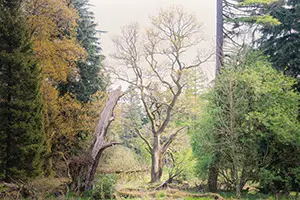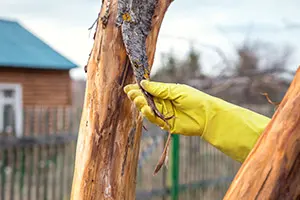Trees are living organisms, which means they will die someday. Dying trees run the risk of disrupting the landscape and safety of your Cahokia, IL home. Therefore, it is necessary to properly remove dying trees and weak trees that could easily be brought down by the summer storms. It is recommended to proactively maintain the trees on your property by keeping a close watch on older trees and checking for symptoms of tree illness. Listed below are five key indicators that it’s time for tree removal.

Lack of Leaves
It is normal for your trees to shed their leaves in the fall and bud again when spring comes around. Perhaps this year you noticed a change in regrowth of leaves compared to prior years. If there are areas where there are few or no leaves, this could be a sign of your tree’s declining health. A dying tree is typically lacking or sparse in leaves and should be evaluated by a professional landscape provider.
Mushroom at the Base of the Tree
Fungus-like organisms such as mushrooms, easily grow on forest floors. It’s bad news for your trees if large colonies of fungus begin to grow at their base. An infection caused by fungus leads to damage to the roots and trunk of the tree. Once the fungus has progressed, very little can be done to save infected trees. Fungicide is not effective with most invasive organisms that commonly attack trees. Trees that have not been hurt by fungus need to be transplanted and removed to prevent the further spread of infection.
Dead Branches
If you have noticed clusters of dead branches on the ground, your tree may have fungus growing at the base. When trees are sick, they often drop these fallen branches, which can increase the spread of tree illnesses. When unattended, these falling branches compromise tree stability and result in potential damage to your property or loved ones.

Bark Health
Observing a tree’s bark can also reveal its health status. If you notice bark that has fallen or has deep cracks, this could be a sign that the tree will need removal. Doing an evaluation such as a “Scratch test” can help indicate the health of a tree. To conduct a scratch test, peel away a small section of bark from a tree. If the underlying color is green, it’s still alive. If the color is brown or dry, then this is a sign of decay.
Trunk Health
While you are evaluating your branches, it’s helpful to look at your tree trunk as well. Hollow portions of a tree typically come from fallen branches that leave a cavity behind. This tends to appear in old, dying trees. If you notice these types of cavities, make sure to have them inspected as soon as possible to avoid costly damage.
While dead and dying trees cannot be saved, it’s important to know the difference between a sick tree and a dying tree. That’s why the experts at Merritt’s Tree Service are here to help. Our professionals are equipped with the knowledge and experience to help evaluate the health of your trees. Give us a call today to see how we can help you take the next step in tree removal.